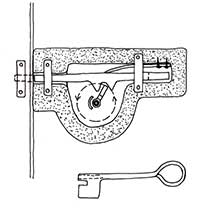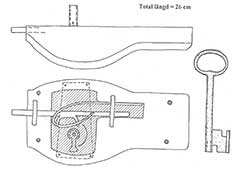Europe
Wooden block locks – with wooden housings and an iron key that turned in an iron mechanism – have been common over much of Europe since the Celtic era. They were found Germany, Austria, France, the UK, and the Netherlands.
Scandinavia
Wooden block locks were placed on the inside of the door. They consisted of an iron bolt built into a hollow in a wooden stock (giving it its name), or a sturdy piece of hardwood. The enclosure was often covered with a thin piece of iron. The first locks were mounted vertically on doors or gateways and had no springs. Horizontally mounted wooden block locks came into use in the late 15th century, when their shape was also modified.
A heavy iron key moved the bolt with the help of two projections on the bolt. In the 14th century, the bolt was held in place with a simple spring plate. In the following century, a tumbler bolt was added for extra security. Many of the larger wooden block locks that are still in use have been reinforced with lengthwise and crosswise iron strips.
 |
| Wooden block lock with spring, bolt, and key of iron, late 14th century. Sketch by the author. |
 |
| Wooden block locks with tumbler, bolt, and key of iron, 18th century. Sketch by the author. |
Wooden block locks were common all over Sweden, even in the Middle Ages. They were used on the doors of early churches, and also on important secular buildings.
Literature
Ole Höjrup. Låse af trae. Folkeliv og kulturlevn. Odense 1960.
Kulturhistoriskt lexikon för nordisk medeltid. Malmö 1956-78.